1993 CHEVROLET CAVALIER rear view mirror
[x] Cancel search: rear view mirrorPage 87 of 308
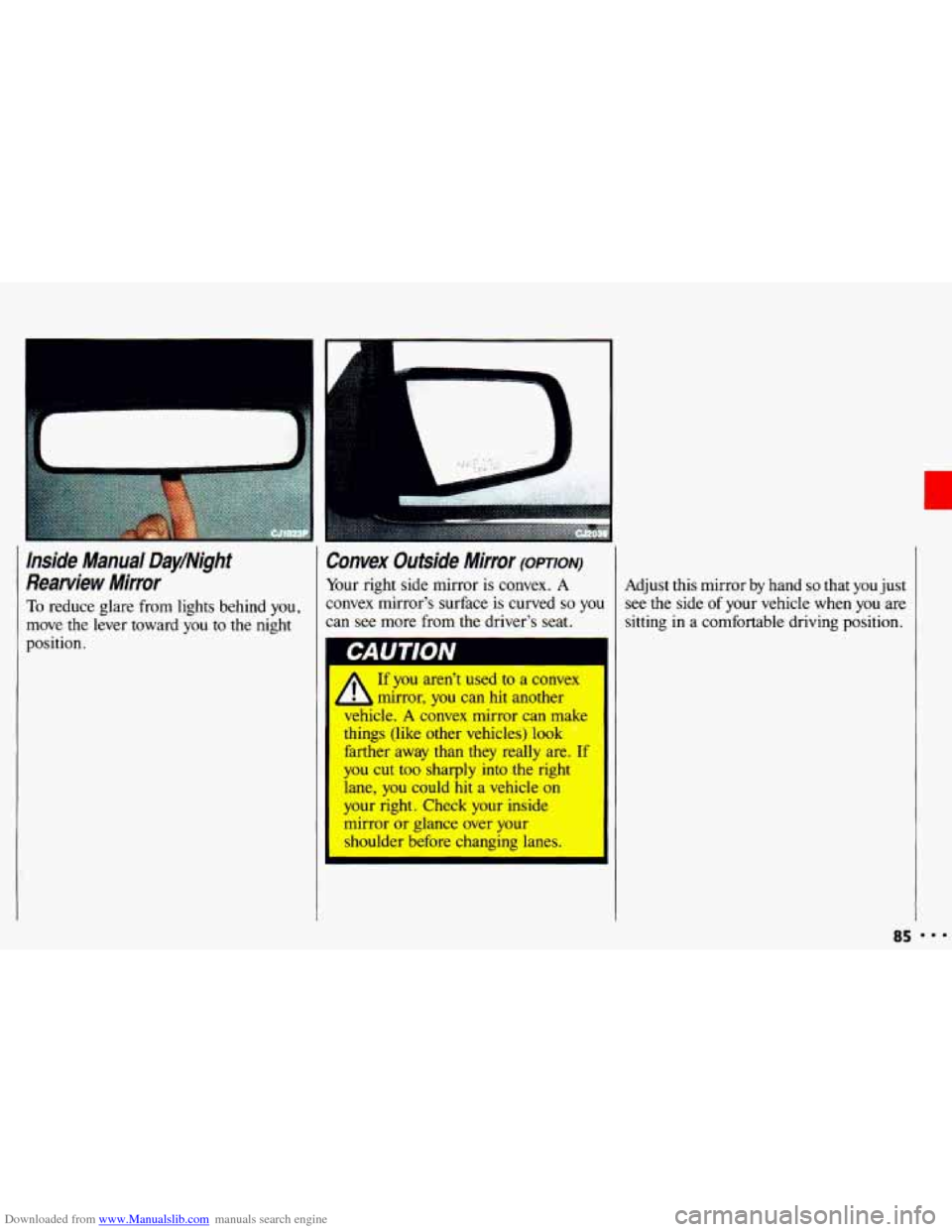
Downloaded from www.Manualslib.com manuals search engine Inside Manual DayINight
Rearview Mirror
To reduce glare from lights behind you,
move
the lever toward you to the night
position.
Convex Outsjde Mirror (OPTION)
Your right side mirror is convex. A
convex mirror’s surface is curved
so you
can see more from the driver’s seat.
I CAUTioN
I
If you aren’t used to a convex
mirror, you can hit another
vehicle.
A convex mirror can make
things (like other vehicles) look
farther away than they really are. If
you cut too sharply into the right
lane, you could
hit a vehicle on
your right. Check your inside
mirror or glance over your
shoulder before changing lanes. Adjust
this mirror
by hand so that you just
see the side
of your vehicle when you are
sitting
in a comfortable driving position.
85
Page 145 of 308
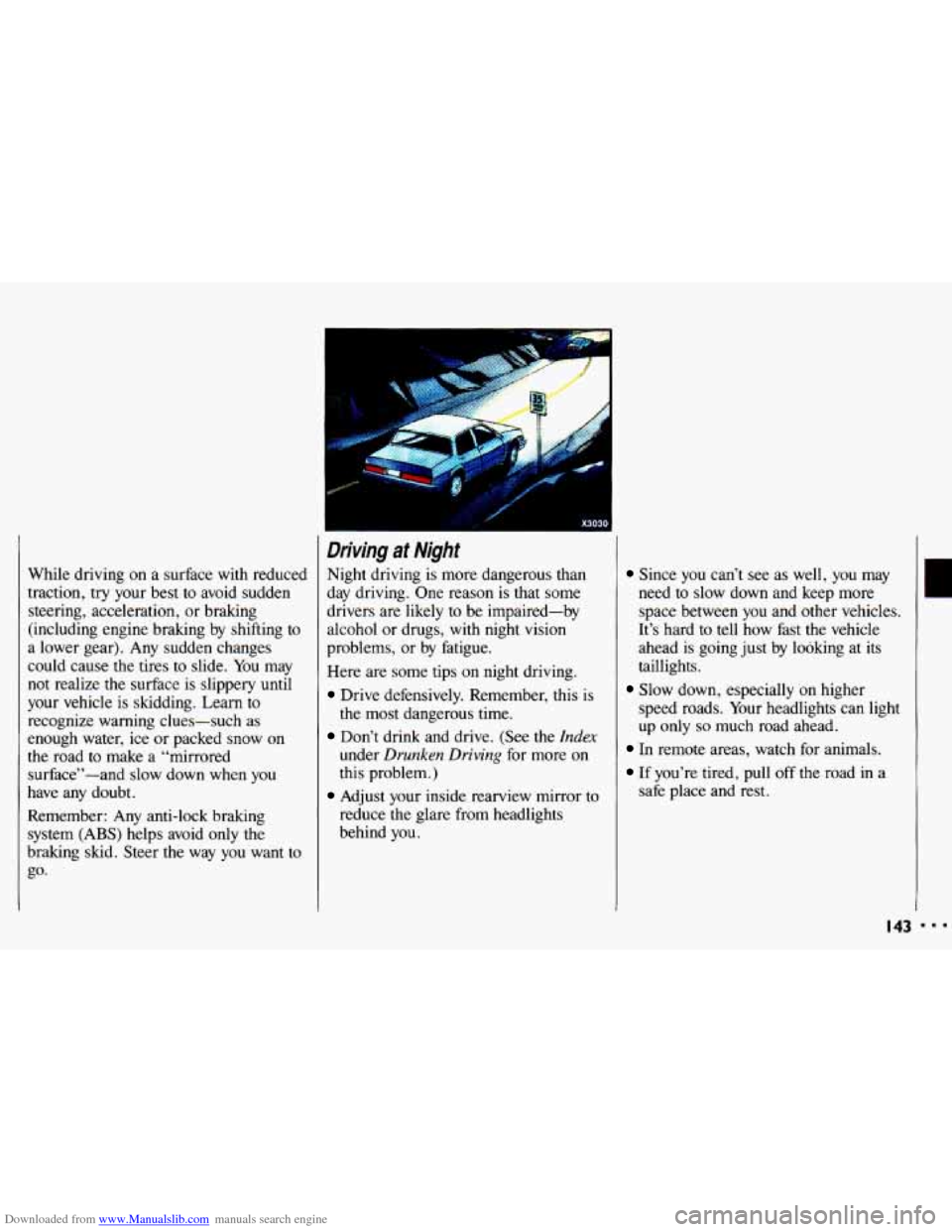
Downloaded from www.Manualslib.com manuals search engine While driving on a surface with reduced
traction,
try your best to avoid sudden
steering, acceleration, or braking
(including engine braking by shifting
to
a lower gear). Any sudden changes
could cause the tires
to slide. You may
not realize
the surface is slippery until
your vehicle is skidding. Learn to
recognize warning clues-such as
enough water, ice or packed snow on
the road
to make a “mirrored
surface”-and slow down when you
have any doubt.
Remember: Any anti-lock braking
system (ABS) helps avoid only the
braking skid. Steer
the way you want to
go.
Driving at Night
Night driving is more dangerous than
day driving. One reason is that some
drivers are likely to be impaired-by
alcohol or drugs, with night vision
problems, or by fatigue.
Here are some tips on night driving.
Drive defensively. Remember, this is
the most dangerous time.
Don’t drink and drive. (See the index
under Drunken Driving for more on
this problem.)
Adjust your inside rearview mirror to
reduce the glare from headlights
behind you.
Since you can’t see as well, you may
need
to slow down and keep more
space between you and other vehicles.
It’s hard to
tell how fast the vehicle
ahead is going just by looking at its
taillights.
speed roads. Your headlights can light
up only
so much road ahead.
Slow down, especially on higher
In remote areas, watch for animals.
If you’re tired, pull off the road in a
safe place and rest.
I43
r
I..
Page 152 of 308
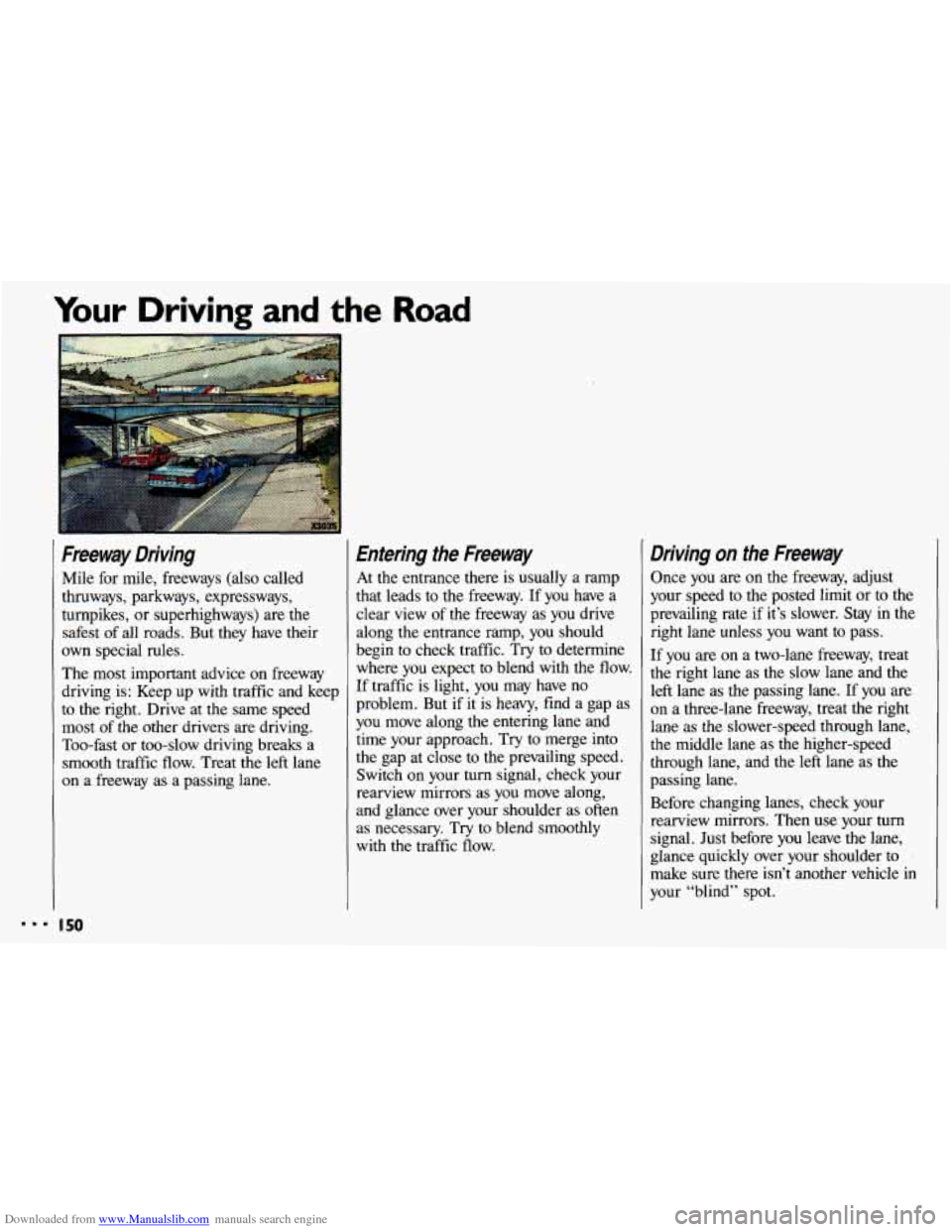
Downloaded from www.Manualslib.com manuals search engine Your Driving and the Road
Freeway Driving
Mile for mile, freeways (also called
thruways, parkways, expressways,
turnpikes, or superhighways) are the
safest of all roads. But they have their
own special rules.
The most important advice on freeway
driving is: Keep up with traffic and keep
to the right. Drive at the same speed
most
of the other drivers are driving.
Too-fast or too-slow driving breaks a
smooth traffic flow. Treat the left lane
on a freeway as a passing lane.
Entering the Freeway
At the entrance there is usually a ramp
that leads to the freeway. If you have a
clear view
of the freeway as you drive
along the entrance ramp, you should
begin
to check traffic. Try to determine
where you expect to blend with the flow.
If traffic is light, you may have no
problem. But if it is heavy, find a gap as
you move along the entering lane and
time your approach.
Try to merge into
the gap at close to the prevailing speed.
Switch on your
turn signal, check your
rearview mirrors as you move along,
and glance over your shoulder as often
as necessary. Try to blend smoothly
with the traffic flow.
Driving on fhe Freeway
Once you are on the freeway, adjust
your speed to the posted limit or to the
prevailing rate
if it’s slower. Stay in the
right lane unless you want to pass.
If you are on a two-lane freeway, treat
the right lane as the slow lane and the
left lane as the passing lane. If you are
on a three-lane freeway, treat the right
lane as the slower-speed through lane,
the middle lane as the higher-speed
through lane, and
the left lane as the
passing lane.
Before changing lanes, check your
rearview mirrors. Then use your
turn
signal. Just before you leave the lane,
glance quickly over your shoulder to
make sure there isn’t another vehicle in
your “blind” spot.
... I 50
Page 155 of 308
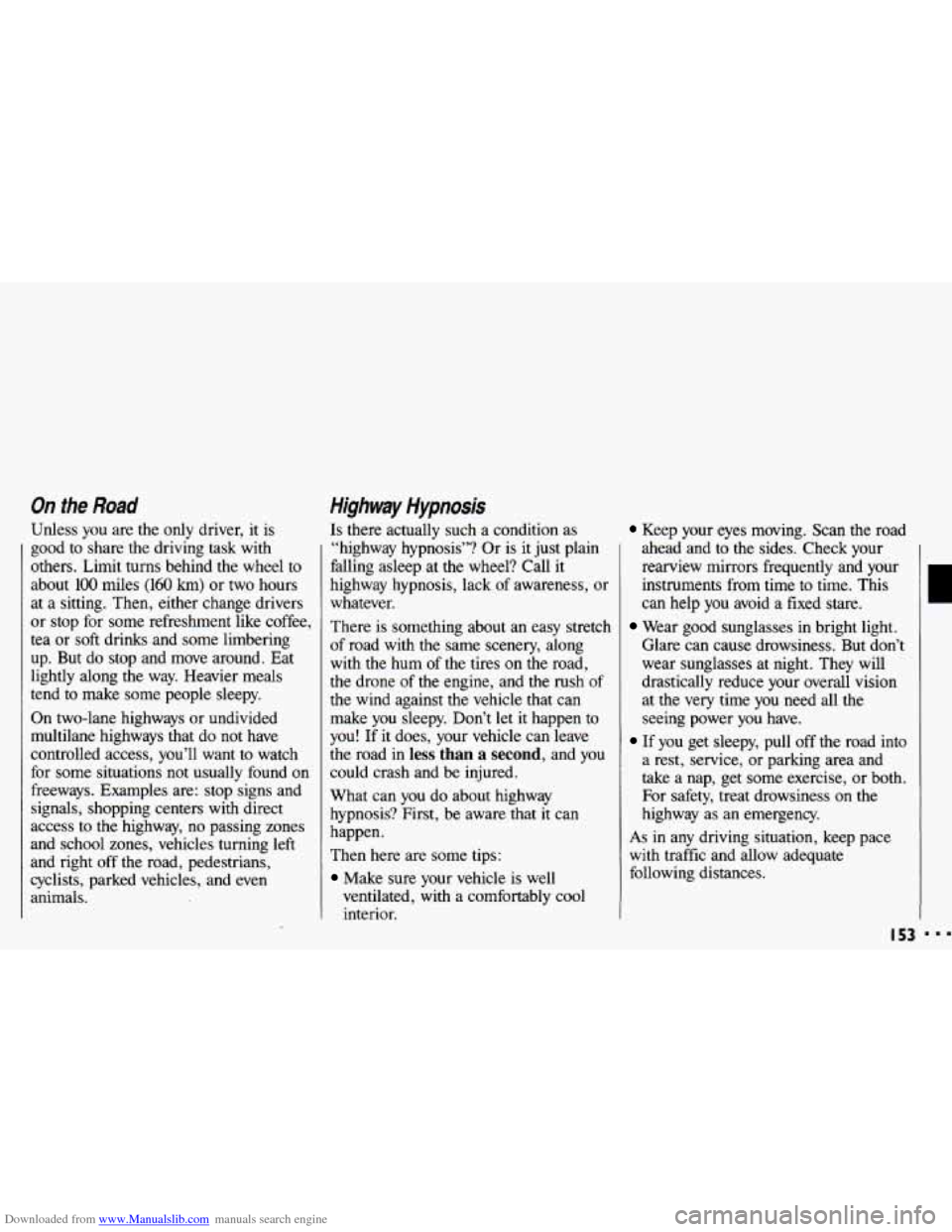
Downloaded from www.Manualslib.com manuals search engine On the Road
Unless you are the only driver, it is
good to share the driving
task with
others. Limit turns behind the wheel
to
about 100 miles (160 km) or two hours
at a sitting. Then, either change drivers
or stop for some refreshment like coffee,
tea or soft drinks and some limbering
up. But do stop and move around. Eat
lightly along the way. Heavier meals
tend to make some people sleepy.
On two-lane highways or undivided
multilane highways that do
not have
controlled access, you’ll want
to watch
for some situations not usually found on
freeways. Examples are: stop signs and
signals, shopping centers with direct
access to the highway, no passing zones
and school zones, vehicles turning left
and right off the road, pedestrians,
cyclists, parked vehicles, and even
animals.
Highway Hypnosis
Is there actually such a condition as
“highway hypnosis”?
Or is it just plain
falling asleep at the wheel? Call it
highway hypnosis, lack
of awareness, or
whatever.
There is something about an easy stretch
of road with the same scenery, along
with the hum
of the tires on the road,
the drone
of the engine, and the rush of
the wind against the vehicle that can
make you sleepy. Don’t let it happen to
you! If it does, your vehicle can leave
the road
in less than a second, and you
could crash and be injured.
What can
you do about highway
hypnosis? First, be aware that it can
happen.
Then here are some tips:
Make sure your vehicle is well
ventilated, with a comfortably cool
interior.
Keep your eyes moving. Scan the road
ahead and to the sides. Check your
rearview mirrors frequently and your
instruments from time to time. This
can help you avoid a fixed stare.
Wear good sunglasses in bright light.
Glare can cause drowsiness. But don’t
wear sunglasses at night. They will
drastically reduce your overall vision
at the very time you need
all the
seeing power you have.
If you get sleepy, pull off the road into
a rest, service, or parking area and
take a nap, get some exercise, or both.
For safety, treat drowsiness on the
highway as an emergency.
As in any driving situation, keep pace
with traffic and allow adequate
following distances.
L
Page 301 of 308

Downloaded from www.Manualslib.com manuals search engine Identification Number.
Vehicle
................. .56. 246
Idling Your Engine
........... .68. 71
Sand. Mud. Ice or Snow
........ 192
If You're Stuck: In
Ignition
Key
......................... 48
Key Release Button ............ 55
Positions
..................... 55
Illuminated Entry System
.......... 50
Indicator Lights (see
Warning Lights)
Infant Restraint (see Child Restraints)
Inflation. Tires ................. 230
Inside Rearview Mirror
........... 85
Instrument Panel ................ 93
Instrument Panel Wming'Lights
.... 96
Intermittent Windshield Wipers
..... 83
.................... J ack. Tire 185
Jump Starting
.................. 164
Key Release Button
............. 55
Keys .......................... 48 Lane
Change Indicator
........... 73
Lap-Shoulder Safety Belt
.......... 23
Front
..................... 23. 27
Rear
........................ 28
Use by Children ........... .33. 43
Latches. Seatback
................ 14
Liftgate Ajar Light
................... 102
Lock
........................ 52
Lock Release
................. 52
Safety Warning
................ 52
Lighter
........................ 87
Dome/Map
................... 82
Headlights
................... 78
Lights
Daytime Running Lights
......... 80
Flash-to-Pass .................. 81
Instrument Panel Intensity Control
... 81
Rear Compartment
............ 82
Removing
& Replacing
Bulbs
........... .224, 225, 253
Replacement Bulbs
........... 253
Taillights
.............. .225. 253
Turn Signal
.................. 73
Warning Lights
............... 96
Loading Your Vehicle
....... .91. 227 Locks
......................... 49
Long Distance Driving
.......... 152
Low Oil Pressure Warning
........ 98
Luggage Carrier
................. 91
Low Battery
................... 164
Maintenance Record
........... 279
Maintenance Schedule
.......... 259
Malfunction Indicator Lamp
(Check Engine Light)
.......... 102
Manual Front Seat
............... 12
Manual Sunroof
................. 88
Manual Transaxle
Adding Fluid
....... .215. 250, 252
Shifting
..................... 64
Master Cylinder. Brake
.......... 221
Methanol in Gasoline
........... 198
Mileage Indicator
Mirrors Checking
Fluid
............... 213
Starting the Engine
............ 56
(see
Odometer & Speedometer)
Convex Outside ............... 85
Inside Manual Day/Night ....... 85
299 m ..
Page 302 of 308
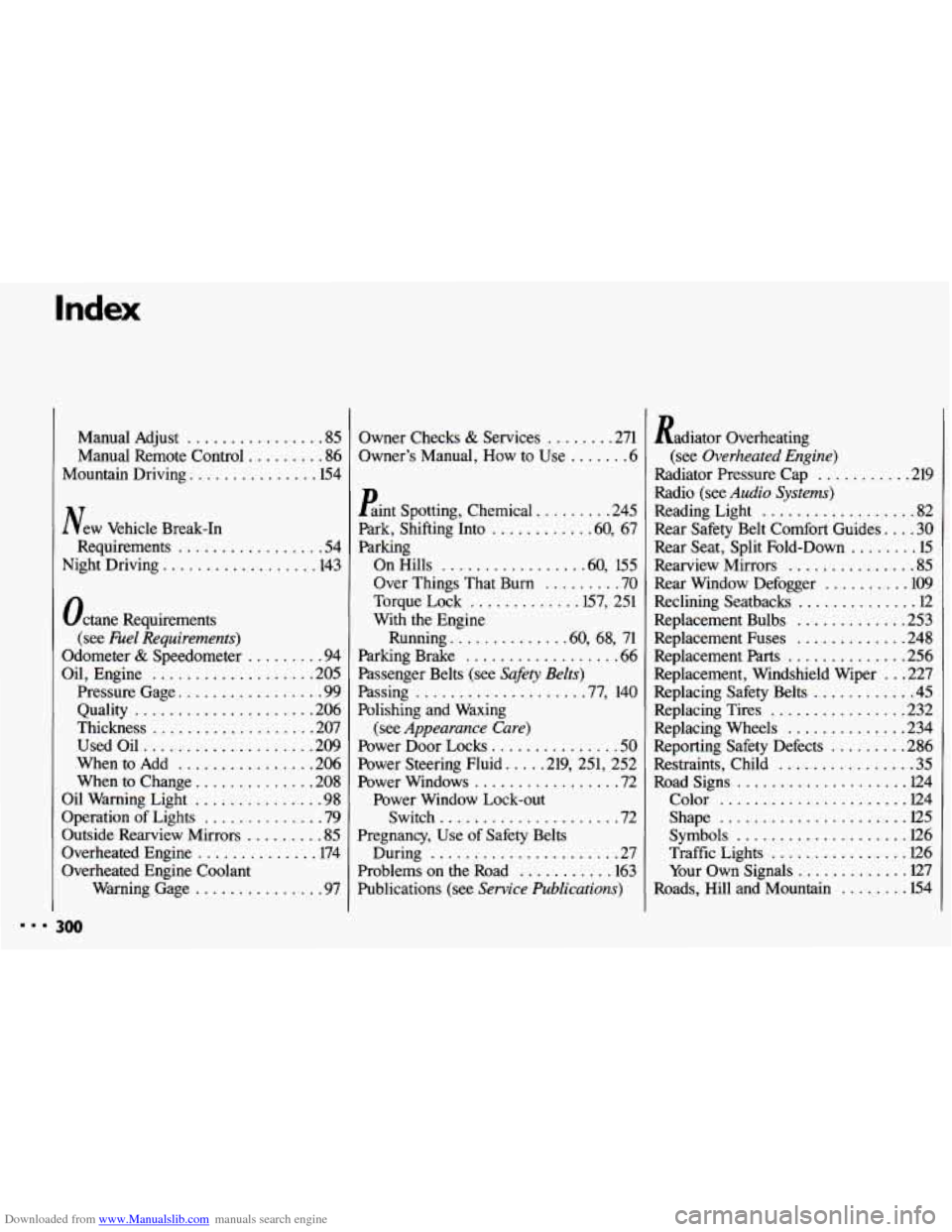
Downloaded from www.Manualslib.com manuals search engine Index
Manual Adjust ................ 85
Manual Remote Control ......... 86
Mountain Driving ............... 154
New Vehicle Break-In
Requirements
................. 54
Night Driving .................. 143
Octane Requirements
Odometer
& Speedometer ......... 94
Oil. Engine ................... 205
Pressure Gage ................. 99
Thickness ................... 207
Used Oil ................... -209
When to Add ................ 206
When to Change .............. 208
Oil Warning Light ............... 98
Outside Rearview Mirrors ......... 85
Overheated Engine .............. 174
Overheated Engine Coolant
Warning Gage
............... 97
(see Fuel Requirements)
Quality ..................... 206
Operation of Lights .............. 79
Owner Checks & Services ........ 271
Owner’s Manual. How to Use ....... 6
Eint Spotting. Chemical ......... 245
Park. Shifting Into ........... .60. 67
Parking
On Hills
................ .60. 155
Over Things That Burn ......... 70
Torque Lock ............ .157. 251
With the Engine
Running
............. .60. 68. 71
Parking Brake .................. 66
Passenger Belts (see Safety Belts)
Passing ................... .77. 140
Polishing and Waxing
Power Door Locks
............... 50
Power Windows ................. 72
Power Window Lock-out
Switch
..................... 72
Pregnancy. Use of Safety Belts
During
...................... 27
Problems on the Road ........... 163
Publications (see Service Publications)
(see Appearance Care)
Power Steering Fluid .... .219. 251. 252
Radiator Overheating
(see
Overheated Engine)
Radiator Pressure Cap ........... 219
Radio (see Audio Systems)
Reading Light .................. 82
Rear Safety Belt Comfort Guides .... 30
Rear Seat. Split Fold-Down ........ 15
Rearview Mirrors ............... 85
Rear Window Defogger .......... 109
Reclining Seatbacks .............. 12
Replacement Bulbs ............. 253
Replacement Fuses ............ -248
Replacement Parts .............. 256
Replacing Safety Belts ............ 45
Replacing Tires ................ 232
Replacing Wheels .............. 234
Reporting Safety Defects ......... 286
Restraints. Child ............... -35
Road Signs .................... 124
Color ...................... 124
Shape ...................... 125
Symbols .................... 126
Traffic Lights ................ 126
Your Own Signals ............. 127
Roads. Hill and Mountain ........ 154
Replacement. Windshield Wiper ... 227